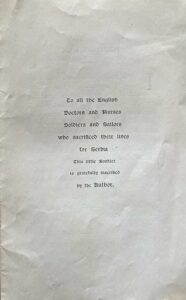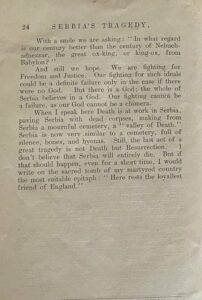3rd December 2024 Belgrade, Serbia
Renewing old ties: the new Bishop of London

I recently had the honour of accompanying His Holiness Patriarch Porfirije back to the UK. It was for a special reason. The Serbian Orthodox Church has created a new diocese of Great Britain and Ireland. On Sunday 24 November, my friend Bishop kyr Nektarije was enthroned as the first Serbian Bishop of London.

The enthronement ceremony took place in the beautiful Cathedral Church of Saint Sava in west London. HRH Prince Michael of Kent represented the Royal Family and HM King Charles sent a personal message, hoping that “the creation of this new diocese will help to refresh and deepen the longstanding ties between the Serbian Orthodox Church and the Church of England, as well as between our peoples.”

Since I arrived in Serbia last summer, I have been fascinated to learn more about these ‘longstanding ties’ between our Churches. It’s a story that has been forgotten by many, but is worthy of remembrance.
At the start of the First World War, Serbia came under attack from Austro-Hungary. The brave soldiers of the Serbian army succeeded in gaining the first Allied victories at the hard-won battles of Cer and Kolubara. However, the respite was only temporary before the Austro-Hungarians came again with the powerful German army, and this time their attacks were supplemented by a lethal typhus epidemic. It was only a matter of time before Serbia would fall.
Serbia’s bravery inspired Britain. Its military victories were celebrated in the streets of our cities. Tens of thousands of people donated to the Serbian Relief Fund founded by Lady Louise Paget, whose impressive array of medals, including the Order of Saint Sava, I saw at the Cathedral in London last week. Even children gave their pocket money. It is quite well-known that hundreds of mainly Scottish women volunteered to come to Serbia as doctors, nurses, ambulance drivers and orderlies. Under the leadership of Dr Elsie Inglis, 14 hospitals were built across Serbia, saving the lives of countless soldiers and civilians. A military mission was also sent to help defend Belgrade and the Danube, under the command of Rear Admiral Sir Ernest Troubridge.
What is perhaps less well-known is that there was traffic in the other direction too. The introduction of rugby in Serbia finds its roots in the boys who were evacuated to the safety of a school in Edinburgh. And, as the Austro-Hungarian occupation took hold, many Serbian clerics and theologians took refuge in Britain too. Amongst their number were two who would later become Saints, Nikolaj Velimirović and Justin Popović.
During their meeting, the Archbishop of Canterbury presented Patriarch Porfirije with a remarkable book called ‘Serbia’s Tragedy.’ The book was published in 1915, at the height of the war and the typhus epidemic, and was signed in his own hand by St Nikolaj Velimirović. It was dedicated “To all the English doctors and nurses, soldiers and sailors, who sacrificed their lives for Serbia.”


Father Nikolaj became a very well-known figure in Britain during the war. He toured the country, rallying support for stricken Serbia. On 23 July 1917, he became the first non-Anglican to preach in St Paul’s Cathedral in London. Many of his speeches and sermons were published to reach a wider British audience which was fascinated by Serbia’s bravery and sacrifice in the face of overwhelming odds. Velimirović believed strongly in Christian unity, and especially in a close relationship between Britain and Serbia, and between the Anglican and Serbian Orthodox churches. Indeed, that was probably one of the reasons why he would later be imprisoned by the Nazis in Dachau. Almost immediately after his release, he travelled back to London with Patriarch Gavrilo to attend the christening at Westminster Abbey of Crown Prince Alexander of Yugoslavia.
After the turbulence of the 1990s, and its long shadow on regional peace and Serbia’s relations with the West, it is incredibly interesting to look back and learn about the close alliance between Britain and Serbia during the First World War – political, military, civil and religious.
I’m happy to say that those ties are remembered even today. In gratitude for the Church of England’s welcome to Serbian clerics, the Patriarch touchingly makes his private chapel available to the small Anglican community in Belgrade to celebrate Christmas and Easter, and also hosted a Memorial Service for Her Late Majesty Queen Elizabeth. It is a wonderful gesture. It forms an important part of the continuing deep relations between the Anglican and Orthodox Churches, two global communities that have in recent decades been in deep direct dialogue with each other – including important conversations in Serbia in 2013 on the theme of hope.
St Nikolaj concludes ‘Serbia’s Tragedy’ as follows: “When I speak here, Death is at work in Serbia… I don’t believe that Serbia will entirely die. But if that should happen, even for a short time, I would write on the sacred tomb of my martyred country the most suitable epitaph: “Here rests the loyallest friend of England.”

Remarkable words then. Even more remarkable over 100 years later. Today, we are friends again. But those words speak to what we have lost. A deep and instinctive understanding, mutual respect, alliance. I hope we can rediscover this as we work together to build a more modern, positive and forward-looking relationship between our countries.
I was privileged to hear Patriarch Porfirije and Archbishop Welby discussing how to strengthen the bonds between our Churches and their future leaders. At Sunday’s enthronement too, it was also wonderful to see the leaders of so many Orthodox, Anglican and Roman Catholic Churches coming together to celebrate. These ties were important in the past and I believe they can be important in the future too. So, like HM The King, I hope that the enthronement of Bishop Nektarije in London will come to be seen as the start of a new chapter, one in which we will refresh, renew and deepen the longstanding ties between our Churches and our peoples.
This is inspiring and should be taught in schools. I am in my 60s and never heard of this close tie with Serbia. Sunday school, comes to mind and Scouts/Guides associations. This will help bridge gaps in our knowledge and create better understanding, tolerance and friendship with Serbians, etc. Thank you, again. (British of African descent)